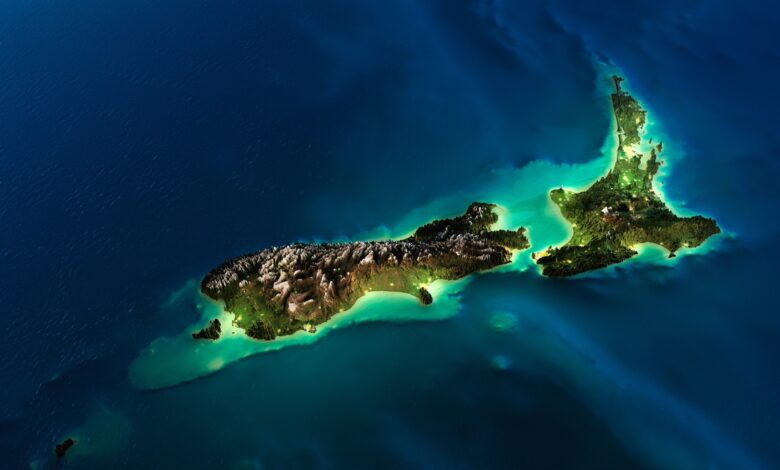Mystery of Zealandia, Earth’s 8th continent, rediscovered after 375 years
At 1.89 million square miles (4.9 million square kilometers), Zealandia is a sizable continent that is around six times larger than Madagascar. There are really 8 continents, according to the scientific team, and the newest one is the tiniest, thinnest, and youngest on record.

The majority of the eighth continent on Earth, Zealandia, was drowned under the ocean. Using information from geological samples taken from the ocean below, geologists have now painstakingly mapped its whole two million square miles. This accurate map reveals Zealandia’s distinctive geological past.
Geological factors caused the supercontinent Gondwana to split apart 83 million years ago, creating the continents we see today. Another result of this process was Zealandia, which is now 94% underwater and just 6% of which remains to create New Zealand and its neighboring islands.
Here is the story of its discovery, research and the mysteries it holds within its lands conspicuous and inconspicuous.
Abel Tasman went on a mission in 1642. The seasoned Dutch sailor was sure that a massive continent existed in the southern hemisphere and was anxious to locate it. He had a flamboyant moustache, a bushy goatee, and a predisposition for harsh justice; he subsequently attempted to hang members of his crew on a whim while intoxicated.
Europeans had an unwavering assumption that there must be a substantial land mass there, which they preemptively called Terra Australis, to balance out their own continent in the North. At the time, this region of the world was still mostly mystery to them. The fixation had existed since the time of the Ancient Romans, but it would only now be put to the test.
So, on August 14, Tasman and two small ships departed from the Indonesian port of Jakarta, where his business was based, and sailed west, south, then east until they reached the South Island of New Zealand.
His first interaction with the Mori inhabitants—who are believed to have arrived in the area centuries earlier—did not go well. On day two, a group of them set out in a canoe and smashed a small boat that was carrying signals between the Dutch ships. Dead were four Europeans. The fate of the Europeans’ targets is unknown after they fired a cannon at 11 additional boats.
With no irony, Tasman gave the place the tragic name Moordenaers (Murderers) Bay, and his mission was over. He sailed home some weeks later without having ever set foot on this new continent. While he was certain that he had found the big southern continent, it was clear that it was not the commercial nirvana he had envisioned. He didn’t come back.
Australia had already been discovered by this point, but the Europeans believed it was not the fabled continent they were seeking for. When they changed their minds, it was given the name Terra Australis.
Tasman had no idea that he had been correct all along. There was a continent missing.
Geologists revealed the discovery of Zealandia
When a team of geologists revealed the discovery of Zealandia, or Te Riu-a-Mui in Mori, they made headlines. It is almost six times the size of Madagascar and spans 1.89 million square miles (4.9 million square kilometers).
The team boldly declared that there are more than seven continents, despite the fact that encyclopedias, maps, and search engines had long maintained that there are only seven. There are really eight of them, and the newest one is the tiniest, thinnest, and youngest in the whole world, shattering all previous records. The problem is that just a few islands, like New Zealand, protrude from the depths of the ocean; 94% of it is submerged.
“This is an example of how something very obvious can take a while to uncover,” says Andy Tulloch, a geologist at the New Zealand Crown Research Institute GNS Science and a member of the team that found Zealandia.
But this is only the start. The continent is still mysterious after four years, with its secrets zealously guarded beneath 6,560 feet (2 kilometers) of water. How did it come to be? What formerly dwelt there? Furthermore, how long has it been submerged?
In actuality, studying Zealandia has never been easy.
James Cook, a British cartographer, was dispatched on a scientific expedition to the southern hemisphere more than a century after Tasman found New Zealand in 1642. He was given explicit orders to track Venus as it moved between the Earth and the Sun in order to determine the Sun’s distance from the Earth.
He did, however, also have a sealed packet with him that he was to open after doing the first duty. This included a top-secret expedition to explore the southern hemisphere, which he may have crossed directly before arriving in New Zealand.
The Scottish scientist Sir James Hector, who participated in an expedition to investigate a group of islands off the southern coast of New Zealand in 1895, acquired the first concrete evidence of Zealandia’s existence. He came to the conclusion that New Zealand is “the remnant of a mountain-chain that formed the crest of a great continental area that stretched far to the south and east, and which is now submerged” after examining their geology.
Despite this early success, there was little progress made until the 1960s about the possibility of a Zealandia. “Things happen pretty slowly in this field,” observes Nick Mortimer, the 2017 study’s principal investigator and a geologist at GNS Science.
Finally, in the 1960s, geologists came to a consensus on what constitutes a continent: generally speaking, a geological region with a high elevation, a diverse range of rocks, and a thick crust. It must also be large. Mortimer asserts, “You just can’t be a little bit. Geologists now had a starting point with which to build their case for the existence of the eighth continent.
The form of Zealandia is another unsolved puzzle.
According to Sutherland, “If you look at a geological map of New Zealand, there are two things that really stand out.” A plate boundary that runs down the South Island and is so important that it can be seen from space is one of them, and it is called the Alpine Fault.
The second is that New Zealand’s geology is strangely twisted, as is the geology of the entire continent. The Pacific and Australian tectonic plates collide, dividing both along a horizontal line. The formerly continuous ribbons of granite no longer line up and are now practically at right angles, as if someone had grabbed the lower half and twisted it away at this precise location.
That the tectonic plates shifted and in some way bent them out of shape is an obvious explanation. But the precise details of how and when this occurred remain a complete mystery.
There are many different interpretations, but Tulloch notes that there are still many unanswered questions.
The continent is unlikely to reveal all of its secrets anytime soon, according to Sutherland. When everything is 2 km (1.2 miles) below and the strata you need to sample are 500 m (1,640 feet) below the seabed as well, he adds, “it’s quite hard to make discoveries.” Going out and exploring a continent like that is incredibly difficult. So, sending ships out to explore areas just requires a lot of time, money, and effort.
Even if nothing else, the existence of the eighth continent in the world proves that, over 400 years after Tasman’s exploration, there is still plenty to learn.
Source:
- Phys.org
- BBC
Please, also have a look into : Friends fly small plane across the continents from USA to India



